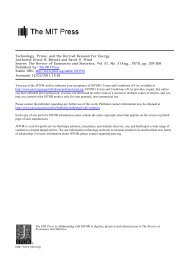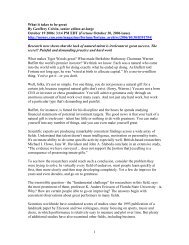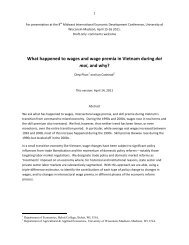Capital-Labor Substitution and Economic Efficiency Author(s): K. J. ...
Capital-Labor Substitution and Economic Efficiency Author(s): K. J. ...
Capital-Labor Substitution and Economic Efficiency Author(s): K. J. ...
You also want an ePaper? Increase the reach of your titles
YUMPU automatically turns print PDFs into web optimized ePapers that Google loves.
CAPITAL-LABOR SUBSTITUTION AND ECONOMIC EFFICIENCY 235<br />
In section C we investigate the possible sources<br />
of bias in our previous estimates of o- in the<br />
light of these findings.<br />
A. Generality of the Production Function<br />
The two tests given in (i 9) <strong>and</strong> (2 i) require<br />
estimates of either the capital stock or the rate<br />
of return on capital. Although such data are<br />
notoriously scarce <strong>and</strong> unreliable, we have been<br />
able to assemble comparable information on<br />
rates of return in four of the industries in Table<br />
2 covering from three to five countries in each<br />
industry.13 The capital stock can be estimated<br />
from the rate of return, r, by the relation:<br />
K= (V-7m)rL/r.<br />
TABLE 3. - TESTS OF THE CES PRODUCTION FUNCTION a<br />
A. Test of Constant <strong>Efficiency</strong>b<br />
The test of constancy of all parameters in-<br />
volves the computation of c in equation (I9).<br />
If there is no variation in efficiency, this num-<br />
ber should remain constant. This calculation is<br />
shown in Table 3-A. The extent of variation in<br />
c is indicated by taking its ratio to the geomet-<br />
ric mean for each industry, J.<br />
It is clear from these results that the hypoth-<br />
esis of constancy in all three parameters must<br />
be rejected, since there is a large variation in c<br />
23I. Spinning & Weaving 31I. Basic Chemicals 34I. Iron <strong>and</strong> Steel 350. Metal Products<br />
C c c c<br />
w r c w r c w r c w r c<br />
United States 2920 .0526 I.72 4754 .2083 2.3I 4387 *I984 2.96 43I4 *I359 2.35<br />
Canada 2708 .0403 i.i6 4036 .2II5 2.0I 3769 *I740 2.13 3507 .I07I I.37<br />
United Kingdom 874 .2022 I.44 .. I224 *I5I3 0.62<br />
Japan 287 .I902 0.55 563 .2373 .70 664 .I9II 0.49 422 .2245 0.3I<br />
India 276 *I543 o.63 320 .2200 .5I 450 .2686 0.53<br />
B. Test of Constant 5'<br />
fi/a, at 'Yi fi/a, at 'Yi fi/ai at, 'i fi/a, aj 'Yi<br />
United States I.I55 .536 i.oi6 3.283 .767 I.02I I.564 .6io I-733 I.039 .509 I-736<br />
Canada I.352 .575 .77I 3.289 .767 .839 I.765 .638 I-378 i.i8o .541 I.292<br />
United Kingdom I-5I4 .602 .880 .. I.. .265 .559 .857<br />
Japan I.833 .647 .428 2.785 .734 .567 I.46I .584 .687 .968 .492 .6I9<br />
India .. .. . 2.967 .748 .44I 1495 .599 .65 7<br />
Mean .590 .754 .598 *5I4<br />
Coefficient of Variationd 5.85 % 1.72 % 3.55 % 3.50 %<br />
C. Test of Constancy of a <strong>and</strong> P<br />
at et at pis ai 6 i at ,8<br />
United States .462 '534 .233 .765 .343 .536 .462 .480<br />
Canada .452 .6iI .242 .796 .336 .593 .448 .529<br />
United Kingdom 410 .62I .. .458 .579 ..<br />
Japan .43 I .790 .297 .826 .444 .648 .53 5 .5I8<br />
India .. .. .298 .883 .442 .66i<br />
Mean .439 .639 .268 .8I8 .405 .603 .482 .509<br />
Coefficient of Variationd 4.I7%o ii.85%o II.I9% 8.04% I2.84% 6.77% 77-4I% 3-79%<br />
a Sources of data: See text.<br />
b Computed from equation (I9).<br />
c Computed from equations (2I) <strong>and</strong> (12), using country values of 3 in computing 'y.<br />
d Defined as I X - _<br />
NX<br />
where Xs is the country value, X is the industry mean, <strong>and</strong> N is the number of observations for the industry.<br />
'3 The rates of return on capital were estimated from<br />
balance sheets of different industries. <strong>Capital</strong> was measured<br />
by net fixed assets (including l<strong>and</strong>) plus cash <strong>and</strong> working<br />
capital. All financial investments were excluded. Total re-<br />
turns to capital were taken to be equal to gross profit from<br />
operations (excluding other income) minus depreciation.<br />
For further details see [I2].<br />
in all four industries. We therefore ab<strong>and</strong>on<br />
the idea that efficiency is the same among coun-<br />
tries <strong>and</strong> look for constancy in either a, /3, or S.<br />
The first would imply that variations in effi-<br />
ciency apply entirely to capital (assumed in<br />
the computation of c in Table 3-A); the second<br />
that they apply entirely to labor; <strong>and</strong> the last<br />
that they affect both factors equally. The logic<br />
of the test was indicated in section JI-D. The<br />
three possibilities are evaluated in Tables 3-B







